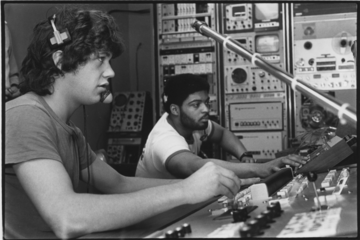
12/01/2017
Michael Flaster ’78 fell in love with radio at an early age, growing up listening to New York City’s titans of music and news, WABC, WINS and WMCA.
When he arrived at SUNY Cortland, Flaster felt at home at the College’s station, WCSU-AM, because of its powerful sound system and robust collection of vinyl records. He and his fellow radio aficionados focused on taking things to the next level.
The station moved to the FM dial, the call letters changed from WCSU to WSUC and a real sense of community was built between the students who worked at the station and its listeners. The experience launched successful media careers, including that of Flaster, who helped establish one of the nation’s first all-news FM radio stations and now runs a San Diego-based media consulting firm.
“When I started at Cortland, the media was available only to those who had really deep pockets or access,” said Flaster of the national communications landscape. “While I was there it became possible for an 18-year-old kid who came from a lower- to middle-class background to connect with an audience and have a full broadcast channel to invent content and create moments. That was what was really wonderful about Cortland. We had the ability to do that.”
That transformative experience was why Flaster and a group of SUNY Cortland’s radio station alumni decided to create the Media Innovation Fund in 2009. The idea was to create a permanent endowment that could provide $1,000 in student grants annually.
These grants would help students gain valuable communications experience outside the classroom. Although today’s students probably won’t climb to the roof of Brockway Hall to install a new radio antenna like Flaster and his friends did, but they grant might enable them to take advantage of similar creative opportunities in fields such as film, television or social media.
Donations, however, were slow to trickle in. By 2016, when SUNY Cortland radio alumni from the mid-1970s met for a reunion, the fund was still $8,000 short of the $25,000 needed to generate the $1,000 annual grant.
Flaster and Robert Bookman ’76, a former columnist and commentator for the College’s newspaper and radio station, told fellow classmates they would match $4,000 in donations so the fund could reach its mark.
About $1,100 came into the fund from alumni, leaving organizers significantly far from their target. So they approached Communication Studies Department chair Paul van der Veur, who generously donated the needed $2,900 needed to trigger Flaster and Bookman’s matching challenge.
“I see it as making a direct connection that benefits our students,” van der Veur said. “In the past 10 years, our enrollment has gone from 250 to 400 and our operating budget has pretty much stayed flat. We need to do a lot more with the same amount.”
Technology plays a critical role in the fast-changing world of communications, but it is hard for the department to provide access to the most up-to-date equipment without resources like the Media Innovation Fund, van der Veur said.
SUNY Cortland’s student-run media operations, including WSUC and The Dragon Chronicle, also provide invaluable experience for students, van der Veur said. He is glad that his gift will help students make the most of those opportunities, as Flaster and Bookman did decades ago.
Flaster studied biology and philosophy at SUNY Cortland but it was his extracurricular radio work that launched his career. After graduation, he worked in managing, producing and programming for public radio and television stations in Cleveland and San Diego. Eventually he founded Traveling Mind Consulting, which helps companies and government agencies make the transition from analog to digital.
Bookman is a partner at Pesetsky & Bookman in New York City, a regulatory law firm for hospitality businesses. He has appeared frequently in the media as an expert on nightlife business and often looks back on his out-of-classroom college experiences as solid preparation for his professional career. Bookman became involved with SUNY Cortland’s radio station through his roles as student government association vice president and chairman of the student senate.
“I saw how formative the radio and the newspaper were for my friends who were running both of those things,” Bookman said. “Anything that we could do to help the school in a specifically-targeted way I thought was a great idea and I jumped in.”
The Media Innovation Fund may wind up being used in ways Bookman, Flaster and van der Veur can't predict. It might support internships or real-life experiences in the film or television industry. Or it might be used to create a new social media app or experiment in a communications field that doesn’t yet exist.
“My memories, which I hope still have currency, are that at Cortland you are able to invent yourself and you’re able to invent a media,” Flaster said. “You’re able to create what hasn’t been created yet. My hope for future students is that whatever the media is, that it will be possible for them to connect with new ideas, to create dialogue, to community build, to learn and live in real time, regardless of the media.”